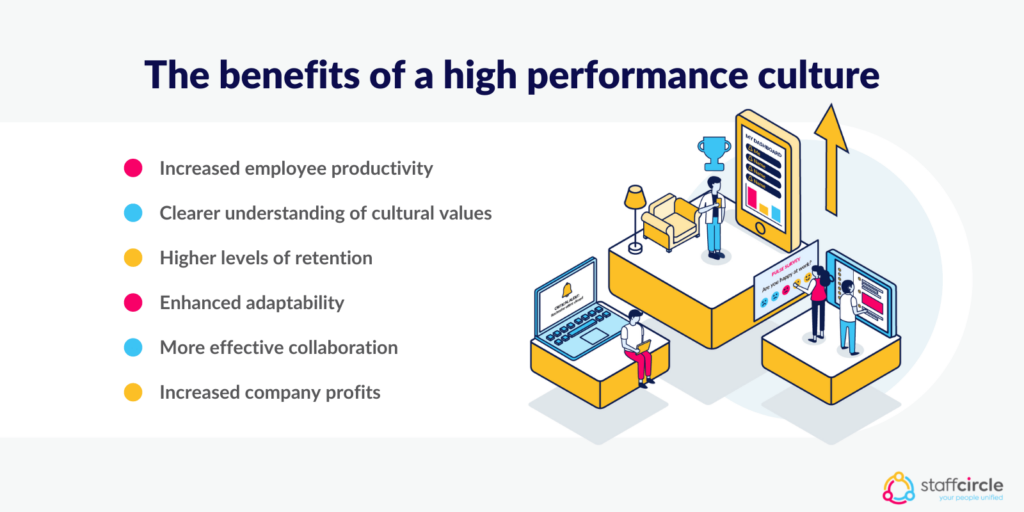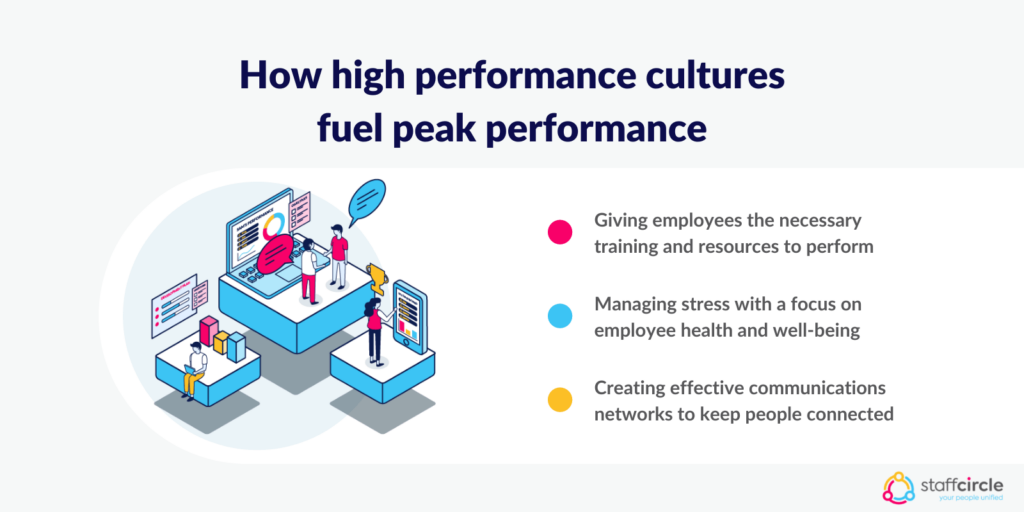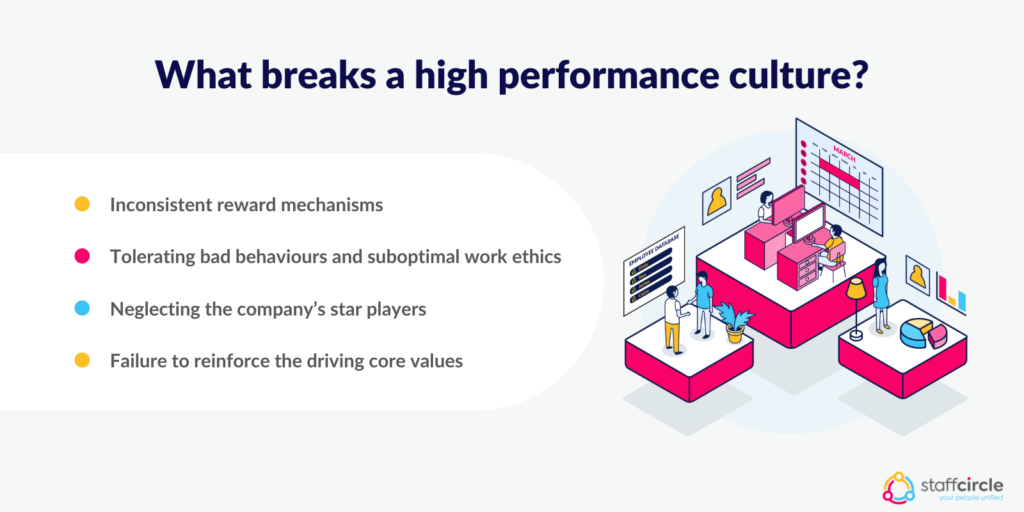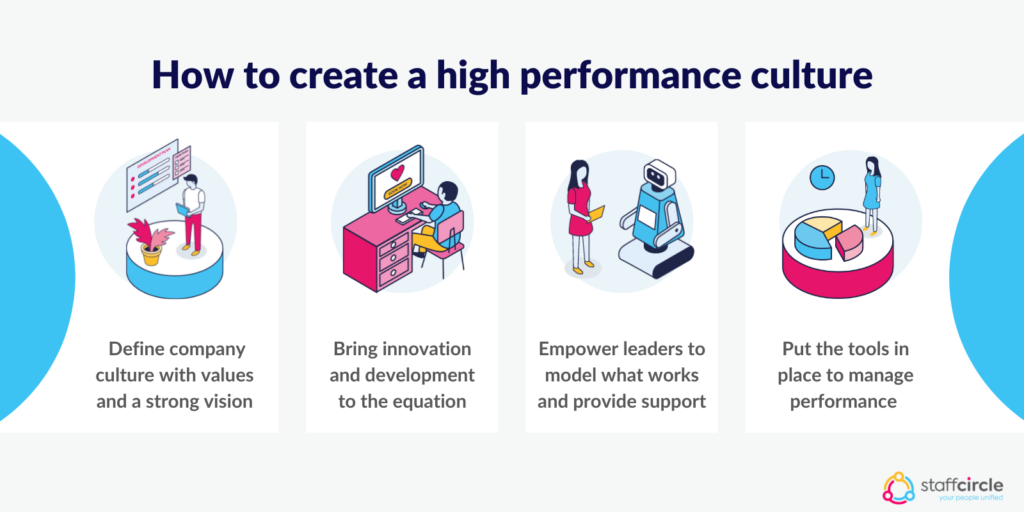High performance cultures are best achieved when the company culture creates a physical or virtual environment where employee engagement is maximised. By creating a set of company core values and behaviours that encourage creative thinking to achieve business goals, organisations can optimise performance across the board.
Some of the common characteristics found in high performance work cultures include:
- Great leaders who understand the organisational culture and reflect it in their attitudes to work, leading by example
- Managers and team leaders who model the behaviours required to deliver the best performance possible will inspire this in their employees and teams
- Employees who feel empowered to deliver their A-game. They are equipped with the skills, knowledge, tools, and resources to get the job done with as much autonomy as possible
- Ongoing processes that encourage the continuous development of talent stacks. Employees are constantly learning so are primed for problem-solving and lateral thinking, capable of rising to any challenges the company faces
- A culture of adaptability. High performance cultures are continually on the lookout for new methods to improve processes, with employees capable of adjusting strategies, processes, and the nature of their roles

Businesses that are seeking to improve their existing organisational culture, to benefit from the benefits of a high performing environment, can work towards this through transformational change programs. An article published by the Harvard Business Review, Three Steps To A High Performance Culture, outlines the necessary actions to achieve this transformation.
- Establish a common understanding of the culture and the metrics used to measure it
- Pinpoint the essential changes to focus on
- Integrate these culture change efforts into business improvement initiatives
The article concludes:
“Executed well, culture change programs using these three steps not only deliver better bottom-line results, but also provide a more fulfilling environment for employees. And for many executives, leading a successful culture-change program is the most rewarding work of their career, because doing so allows them to integrate the human factors that matter to everyone with business concerns.”
Let’s take a closer look at the benefits you can expect from achieving a high performance culture, and the steps you can implement to help create one in your organisation.
Benefits of High Performance Cultures
High performance cultures bring with them a wide variety of benefits, as individuals and teams become more productive in their work and increasingly likely to deliver exceptional results. High performing individuals are more likely to be correctly aligned with company values and culture, working to achieve goals without the need for micromanagement from their managers.

Some of the core benefits you can expect from a high performance culture include:
- Increased employee productivity, due to greater clarity of their role, responsibilities, and work expectations
- A clearer understanding of cultural values, with culture feedback mechanisms ensuring employees are part of the conversation about what core values matter the most
- Higher levels of retention, as employees are able to understand their impact on the overall company mission and goals
- Enhanced adaptability, with a greater degree of creative thinking fostering a diverse selection of problem-solving responses
- More effective collaboration between colleagues through a stronger shared vision of what the best results look like
- Increased company profits, as optimal performance leads to more outstanding work being done
How a high performance culture fuels peak performance
High performance cultures help to create the perfect environment for peak performance, encouraging employees to be the best they can be. When employee performance reaches its peak, employees execute their tasks with high levels of skill and with minimal errors. Even if they do get something wrong, they are able to adapt to the circumstances and bring solutions to the table.

High performance cultures fuel peak performance by:
- Giving employees the necessary training and resources to perform to the best of their abilities. This means going beyond basic training and delivering coaching and mentorship programs that get to the heart of their unique abilities and enhances their talent stack.
- Managing stress with a focus on employee health and well-being. Each individual has their own stress triggers, and a high performance organisational culture is designed to help identify where this lies to avoid burnout and overworking.
- Creating effective communications networks to keep people connected. Regular conversations between managers and employees, as well as peer-to-peer discussions and performance reviews, help to ensure that everyone remains on the same page. By using a multi-channel communications platform, business leaders can make sure everyone stays in the loop, working towards shared goals.
Examples of a high performance culture
There are many organisations that have successfully implemented high performance cultures in the workplace. Here are some stand-out examples to use as inspiration when implementing a high performance culture in your company.
Arts Council England
Arts Council England worked towards creating a high performance culture by promoting partnerships and collaborations that unified different regional boards. This helped give employees the sense they are part of something bigger than themselves through a more cohesive organisation.
Individuals are encouraged to develop their core competencies, while leaders work to foster a culture of collaboration. Cross-departmental groups were established to enhance cultural enthusiasm, facilitated by real-time communication systems.
Workiva
Workiva delivers cloud platform solutions to help companies manage data across departments, with a culture built around giving and receiving feedback on a regular basis. This means having leaders who model open feedback, admitting mistakes, and encouraging ongoing conversations.
This can be easily replicated by using performance management software with consistent feedback mechanisms built into it, combined with an understanding of how to give feedback the right way.
What breaks a high performance culture?
Once high performance cultures have been successfully implemented, it’s important to recognise the factors that can lead it to fall apart. Great company culture can easily be eroded under the right conditions, so understanding what those conditions are is important if companies are to avoid falling into decline.

High performance cultures can be broken because of:
- Inconsistent reward mechanisms. A strongly defined culture works when everyone understands that their contributions are appreciated fairly. If rewards and recognition appear to be unevenly distributed, employees will feel as if the company is playing favourites and their work will suffer.
- Tolerating bad behaviours and suboptimal work ethics. A high performance culture requires a commitment to high performance from everyone involved. If managers and team leaders accept mediocrity from certain employees, the culture will inevitably slide into mediocrity as work expectations decline.
- Neglecting the company’s star players. While leaders need to work to ensure under-performing employees are equipped with the knowledge and skills to up their game, they also need to communicate regularly with their star players. Just because an employee is performing well, it doesn’t mean they aren’t in need of guidance to maintain the same course. Denying leadership development opportunities may force the star players to look elsewhere.
- Failure to reinforce the core values driving a high performance culture. Company culture requires continuous reinforcement in order for the message to stay relevant at all times. This means placing those values at the front and centre of the company’s physical or virtual environment so the message remains embedded in the workforce.
How to create a high performance culture
There are a variety of steps business leaders can take to transform their company and create a high performance culture. Let’s take a look at these steps in more detail.
1. Defining company culture with values and a strong vision
A high performing culture begins with a core mission statement and expression of the company values needed for it to succeed. As the article from McKinsey explains:
“Shifting the culture of any organisation takes time, effort, and commitment. But it begins with clear, visible changes in behavior, especially by the leaders of that organisation.”
This means creating a culture that encompasses a shared vision of what success looks like, involving employees in how it is defined to ensure strategic clarity.
2. Bringing innovation and development to the equation
Innovative companies understand that this process is both top-down and bottom-up, and the key to this symbiotic approach to creative thinking is consistent knowledge sharing. By using the company’s social intranet and other resources, business leaders can foster conversations to help employees develop skills and deliver innovative solutions to complex problems.

3. Empowering leaders to model what works and support employees in achieving goals
Great leaders are those who both model the behaviours expected from individuals and teams, as well as guide and support employees in the right direction. By empowering leaders to both support and challenge their staff, companies are more able to affect the personal and professional development of individuals and achieve the best performance possible.
4. Putting the tools in place to manage performance
High performance cultures only succeed when clear key performance indicators for success are established and monitored. This means putting the necessary tools in place to establish goals, monitor performance, and deliver real-time feedback to keep everything on track.
Summary
With many businesses facing company culture crises, working to shift organizational culture toward one that delivers high performance is crucial to supporting business goals and delivering success.
Redefining cultural values, establishing a clear mission statement which galvanises the workforce, and putting the necessary tools in place to maintain a high performance culture will transform an average company into one that performs above and beyond the competition.





